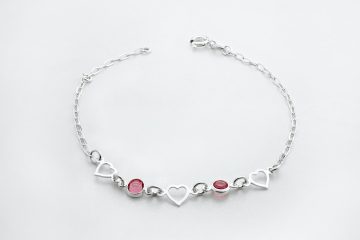Are you interested in creating beautiful and personalized accessories? Look no further! In this comprehensive beginner’s guide, we will take you through the art of knot bracelet making. Knot bracelets are not only trendy and fashionable but also provide a fantastic opportunity to explore your creative side. Whether you want to make them for yourself or as unique gifts for your loved ones, this guide will equip you with the essential knowledge and skills to master the art of knot bracelet making. So grab your materials and let’s get started!
1. Introduction to Knot Bracelet Making
Knot bracelet making is a fun and rewarding craft that allows you to create beautiful and intricate designs using various types of knots. These bracelets can be made from different materials such as cotton, nylon, hemp, or leather. The possibilities are endless, as you can experiment with different colors, textures, and patterns to create unique pieces of jewelry.
2. Understanding the Basic Materials
Before diving into knot bracelet making, it’s essential to familiarize yourself with the basic materials you’ll need. Here are the key components:
2.1 Bracelet Cord
The bracelet cord is the main material used to create the knots. It can be made from various materials, including cotton, nylon, hemp, or leather. Each material has its own unique characteristics, so it’s worth experimenting to find the one that suits your style and preferences.
2.2 Closure Options
There are several closure options you can choose from when making knot bracelets. Some popular choices include lobster clasps, button closures, or sliding knots. Consider the functionality and aesthetics of each closure option to determine which one works best for your design.
2.3 Beads and Charms
To add an extra touch of personalization to your knot bracelets, you can incorporate beads or charms. These embellishments come in various shapes, sizes, and materials, allowing you to create customized designs that reflect your personality or the recipient’s taste.
3. Essential Techniques for Knot Bracelet Making
To create stunning knot bracelets, you need to learn a few fundamental techniques. Here are three essential techniques to get you started:
3.1 Square Knot
The square knot is one of the most basic and versatile knotting techniques used in bracelet making. It involves crossing two cords over each other, then passing the ends through the space created to form a knot. Practice this technique until you can create a neat and symmetrical square knot.
3.2 Half Hitch Knot
The half hitch knot is another vital technique that allows you to create diagonal patterns or add beads to your bracelet. It involves tying a simple knot around one cord using another cord. This technique is ideal for adding visual interest and depth to your designs.
3.3 Alternating Square Knots
The alternating square knot technique is an excellent way to create a braided effect in your bracelet. It involves repeating the square knot technique alternately with two sets of cords. This technique adds texture and dimension to your bracelets.
4. Step-by-Step Guide to Making a Simple Knot Bracelet
Now that you have a grasp on the basic techniques, let’s walk through a step-by-step guide to making a simple knot bracelet. For this project, we will use a cotton cord and a button closure.
4.1 Step 1: Gather your materials
To get started, gather your materials, including a cotton cord, a button closure, scissors, and tape. Choose a cord color that complements your style or the recipient’s preferences.
4.2 Step 2: Measure and cut the cord
Measure your wrist and add a few inches to determine the length of the cord you’ll need. Cut two equal lengths of cord using scissors.
4.3 Step 3: Prepare the cords
Tape one end of the cords together, leaving a small loop at the opposite end. This loop will serve as your anchor point while making the bracelet.
4.4 Step 4: Start with the square knot
Take the left cord and cross it over the right cord, forming a loop. Pass the right cord under the left cord and through the loop. Pull both cords tightly to create a square knot.
4.5 Step 5: Repeat the square knot
Repeat the square knot using the opposite cords. Cross the right cord over the left cord, form a loop, and pass the left cord under and through the loop. Pull tightly to form another square knot.
4.6 Step 6: Continue the pattern
Continue alternating the square knot technique until the bracelet reaches the desired length. Make sure to keep the knots tight and consistent for a professional finish.
4.7 Step 7: Add the button closure
Once you reach the desired length, remove the tape from the anchor end. Attach the button closure to one cord end, and create a loop with the other cord end to secure the bracelet.
4.8 Step 8: Finishing touches
Trim any excess cord, leaving a small tail for a clean finish. You can also add a drop of glue to secure the knots and prevent them from unraveling over time.
Congratulations! You’ve just made your first knot bracelet. With practice and experimentation, you can now create more intricate designs and incorporate different knotting techniques to elevate your bracelet-making skills.
5. Troubleshooting Common Issues
Even with careful attention to detail, you may encounter some common issues while making knot bracelets. Here are a few troubleshooting tips to help you overcome them:
5.1 Loose Knots
If your knots aren’t holding tightly, try pulling each cord individually while holding the opposite cord firmly. This will ensure the knot is snug and secure.
5.2 Uneven Knots
To achieve even knots, pay attention to the tension applied when creating each knot. Keep the tension consistent throughout the bracelet to maintain a uniform appearance.
5.3 Tangling Cords
If your cords become tangled while working on your bracelet, take a moment to untangle them gently. Working with organized cords will make the knotting process smoother and more enjoyable.
Conclusion
Knot bracelet making is a captivating craft that allows you to create stunning and personalized accessories. By understanding the basic materials, learning essential techniques, and following a step-by-step guide, you can master the art of knot bracelet making. With practice and creativity, you’ll be able to design intricate patterns and unique combinations of knots, creating bracelets that reflect your style and personality.
FAQs
1. Q: Can I use different materials for knot bracelet making?
A: Absolutely! Knot bracelets can be made from various materials such as cotton, nylon, hemp, or leather. Experiment with different materials to find the one that suits your preferences.
2. Q: Where can I find beads and charms for my knot bracelets?
A: Beads and charms can be found at craft stores, online marketplaces, or specialized jewelry supply shops. Explore different options to find the perfect embellishments for your designs.
3. Q: Can I make knot bracelets for children?
A: Knot bracelets can be suitable for children, but ensure that the materials and closures used are age-appropriate and safe. Always supervise children during the bracelet-making process.
4. Q: How long does it take to make a knot bracelet?
A: The time required to make a knot bracelet depends on the complexity of the design and your level of expertise. Simple bracelets can be completed in under an hour, while more intricate patterns may take several hours or multiple sessions.
5. Q: Can I sell the knot bracelets I make?
A: Absolutely! If you enjoy making knot bracelets, you can consider selling your creations online, at local markets, or through social media platforms. Ensure you comply with any legal requirements for selling handmade jewelry in your jurisdiction.
Now that you have all the knowledge and guidance needed, it’s time to unleash your creativity and start making beautiful knot bracelets. Enjoy the process, experiment with different techniques, and let your imagination soar!




